| dc.contributor.author | Eide, Erik | |
| dc.date.accessioned | 2012-10-12T08:31:03Z | |
| dc.date.available | 2012-10-12T08:31:03Z | |
| dc.date.issued | 2012 | |
| dc.identifier.uri | http://hdl.handle.net/11250/182938 | |
| dc.description | Master's thesis in Offshore Technology | no_NO |
| dc.description.abstract | Due to the extension of the Gullfaks license, Statoil needs to perform several upgrades to systems to
satisfy today’s regulations. Today`s system consist of two large single point moored offloading buoys,
SPM 1 and SPM 2. Statoil wishes to replace these with a new type of offloading system. The old
system is just too expensive to maintain and will demand a comprehensive upgrade to meet the new
regulations. The solution is to replace the existing system with a new system which is less expensive
to maintain.
The existing offloading system consists roughly of a column from seabed to above sea surface, a
connection plate and a subsea base structure. This thesis has focused on investigating necessary
subsea structure modifications in order to use the existing base structure as interface for the new
offloading system.
An investigation of the condition of the existing system has been performed, resulting in evaluations
and recommendations regarding how to disconnect the connection plate and column from the base
structure, and what measures must be taken in order to install a new system on the existing base.
The connection plate and column should be disconnected by a combination of ROV and diver
assisted operations. The recommended solution is to use ROV in most cases due to economical and
safety aspect of the operation. The disconnection will result in good connection possibilities for the
new system, regarding both oil flow and locking mechanism. A riser base must be installed onto the
base structure, working as an adapter between the base structure and the new offloading system.
The investigation revealed that extra sacrificial anodes need to be installed in order to restore
sufficient cathodic protection of the structure. The result of a strength analysis performed in
SolidWorks Simulation carried out on possible mounting points was very satisfactory and maximum
stresses did not exceed 144,6 MPa with a safety factor of 1,5. The yield strength of the material is
minimum 310 MPa.
The base structure is well suited for connecting a new system to the already existing infra-structure.
However, this thesis only covers an investigation of what needs to be done. More detail planning and
design and production of custom made tooling will be necessary in order to disconnect the
connection plate and column. | no_NO |
| dc.language.iso | eng | no_NO |
| dc.publisher | University of Stavanger, Norway | no_NO |
| dc.relation.ispartofseries | Masteroppgave/UIS-TN-IKM/2012; | |
| dc.subject | SPM | no_NO |
| dc.subject | offloading buoy | no_NO |
| dc.subject | Gullfaks | no_NO |
| dc.subject | subsea structure modification | no_NO |
| dc.title | Investigation of necessary subsea structure modifications prior to installation of new offloading system at Gullfaks | no_NO |
| dc.type | Master thesis | no_NO |
| dc.subject.nsi | VDP::Technology: 500::Marine technology: 580 | no_NO |
